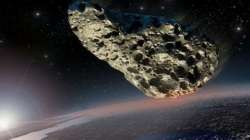NASA's new secret about asteroids is shocking! Know more
The team analysed rock fractures on asteroid Bennu from high-resolution images taken by the spacecraft OSIRIS-REx (Origins, Spectral Interpretation, Resource Identification, Security-Regolith Explorer).

Scientists from NASA's OSIRIS-REx have found that the Sun's heat fractures rocks on Bennu in just 10,000 to 100,000 years, revealing that surface regeneration happens a lot quicker on asteroids than on Earth.
For the findings, the team analysed rock fractures on asteroid Bennu from high-resolution images taken by the spacecraft OSIRIS-REx (Origins, Spectral Interpretation, Resource Identification, Security-Regolith Explorer).
This information will help scientists estimate how long it takes boulders on asteroids like Bennu to break down into smaller particles, which may either eject into space or stay on the asteroid's surface.
Tens of thousands of years might sound pretty slow, but "we thought surface regeneration on asteroids took a few millions of years," said Marco Delbo, senior scientist at Universite Cote d'Azur, France.
"We were surprised to learn that the ageing and weathering process on asteroids happens so quickly, geologically speaking," Delbo said.
Rapid temperature changes on Bennu have created internal stress that fractures and breaks down rocks, similar to how a cold glass breaks under hot water.
The Sun rises every 4.3 hours on Bennu. At the equator, daytime highs can reach almost about 127 Celsius, and nighttime lows plummet to nearly minus 23 Celsius.
OSIRIS-REx scientists spotted cracks in the rocks in spacecraft images from the first surveys of the asteroid. The fractures seemed to point in the same direction, "a distinct signature that temperature shocks between the day and the night could be the cause", said Delbo.
Delbo and his colleagues measured the length and angles of more than 1,500 fractures in OSIRIS-REx images by hand: some shorter than a tennis racket, others longer than a tennis court.
They found the fractures predominantly align in the northwest-southeast direction, indicating they were caused by the Sun, which is shown here to be the primary force changing Bennu's landscape.
"If landslides or impacts were moving boulders faster than the boulders were cracking, the fractures would point in random directions," said Delbo.
The scientists used a computer model and their fracture measurements to calculate the 10,000 to 100,000-year timeframe for thermal fractures to propagate and split rocks.
"The thermal fractures on Bennu are quite similar to what we find on Earth and on Mars in terms of how they form," said Christophe Matonti, a co-author of the paper at Universite Cote d'Azur, CNRS, Observatoire de la Cote d'Azur, Geoazur, Sophia-Antipolis, Valbonne, France.
"It is fascinating to see that they can exist and are similar in very 'exotic' physical conditions [low gravity, no atmosphere], even compared to Mars."
OSIRIS-REx will return a sample from Bennu to Earth on September 24, 2023.
ALSO READ | SpaceX sends 46 Starlink satellites into space
ALSO READ | NASA aiming for late August test flight of giant moon rocket